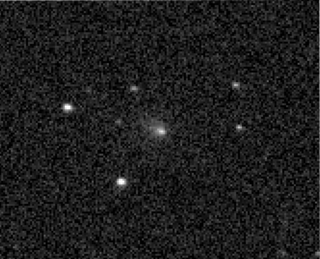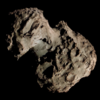Damocloids are a class of minor planets such as 5335 Damocles and 1996 PW that have Halley-type or long-period highly eccentric orbits typical of periodic comets such as Halley's Comet, but without showing a cometary coma or tail. David Jewitt defines a damocloid as an object with a Jupiter Tisserand invariant (TJ) of 2 or less, while Akimasa Nakamura defines this group with the following orbital elements:

Comet Giacobini–Zinner is a periodic comet in the Solar System. It was discovered by Michel Giacobini, who observed it in the constellation of Aquarius on 20 December 1900. It was recovered two orbits later by Ernst Zinner, while he was observing variable stars near Beta Scuti on 23 October 1913.

5D/Brorsen was a periodic Jupiter-family comet discovered on February 26, 1846, by Danish astronomer Theodor Brorsen. The comet was last seen in 1879 and is now considered lost.

47P/Ashbrook–Jackson is a periodic comet in the Solar System.

48P/Johnson is a periodic comet in the Solar System.

105P/Singer Brewster is a periodic comet in the Solar System. It was discovered in 1986, and received the name of 1986d under the old naming system.

11P/Tempel–Swift–LINEAR is a periodic Jupiter-family comet in the Solar System.

C/1992 J1 (Spacewatch) is a comet that was discovered 1 May 1992 by David Rabinowitz of the Spacewatch Project. This was the first comet to be discovered using an automated system.

C/1980 E1 is a non-periodic comet discovered by Edward L. G. Bowell on 11 February 1980 and which came closest to the Sun (perihelion) in March 1982. It is leaving the Solar System on a hyperbolic trajectory due to a close approach to Jupiter. In the 43 years since its discovery only two objects with higher eccentricities have been identified, 1I/ʻOumuamua (1.2) and 2I/Borisov (3.35).

The Great Comet of 1823, also designated C/1823 Y1 or Comet De Bréauté-Pons, was a bright comet visible from December 1823 to April 1824.
C/2001 OG108 (LONEOS) is a Halley-type comet with an orbital period of 48.51 years. It was discovered on 28 July 2001 by the LONEOS telescope at Lowell Observatory. Of the short-period comets with known diameters and perihelion inside the orbit of Earth, C/2001 OG108 is the second largest after Comet Swift–Tuttle.
In observational astronomy, the observation arc of a Solar System body is the time period between its earliest and latest observations, used for tracing the body's path. It is usually given in days or years. The term is mostly used in the discovery and tracking of asteroids and comets. Arc length has the greatest influence on the accuracy of an orbit. The number, spacing of intermediate observations, and timestamps have a lesser effect.

64P/Swift–Gehrels is a periodic comet in the Solar System which has a current orbital period of 9.23 years.

205P/Giacobini is a periodic Jupiter-family comet with an orbital period of 6.68 years. It was discovered by Michel Giacobini on 4 September 1896 and then it was lost until it was recovered by Koichi Itagaki on 10 September 2008. The comet was then found to have fragmented into three pieces.

C/2023 E1 (ATLAS) is a periodic comet with an orbital period of 85 years. It fits the classical definition of a Halley-type comet with an orbital period of between 20 and 200 years. The comet was discovered on 1 March 2023 by ATLAS South Africa. Upon discovery, the comet had an apparent magnitude of about 19 and had a very condensed coma. The comet was subsequently found in images obtained by other observatories back on 25 December 2022.
C/2024 L5 (ATLAS) is a comet that was discovered on 14 June 2024 as A117uUD by the Asteroid Terrestrial-impact Last Alert System (ATLAS), South Africa, Sutherland. It will reach perihelion on 10 March 2025 at 3.432 AU (513.4 million km) from the Sun.
Comet Donati, formally designated as C/1855 L1, is a long-period comet that has an orbital period of approximately 252 years. It was the second comet discovered in 1855, and the first of five comets discovered by Italian astronomer, Giovanni Battista Donati.
C/2024 E1 (Wierzchoś) is a hyperbolic Oort cloud comet, discovered on 3 March 2024 by Polish astronomer Kacper Wierzchoś. It will reach perihelion on 20 January 2026, when it could reach an apparent magnitude of +5.

C/1892 E1 (Swift) is a non-periodic comet discovered by Lewis A. Swift on 7 March 1892. The comet became visible with naked eye.
Comet Brooks–Swift, also known as C/1883 D1 by its modern nomenclature, is a hyperbolic comet that was visible telescopically to Earth in the early months of 1883. It was discovered independently by two American astronomers, William Robert Brooks and Lewis A. Swift.















